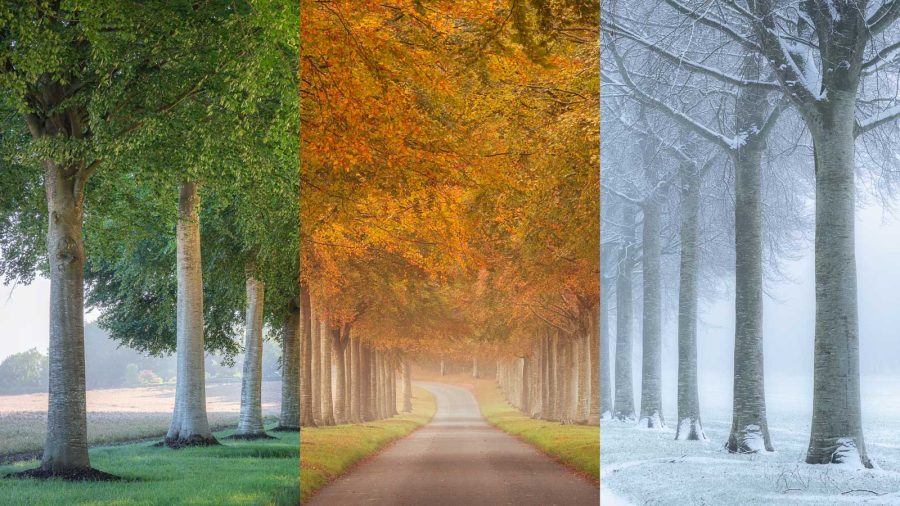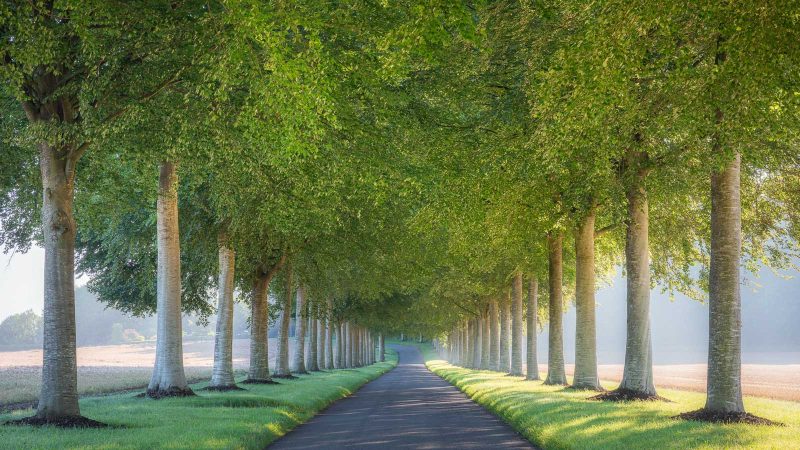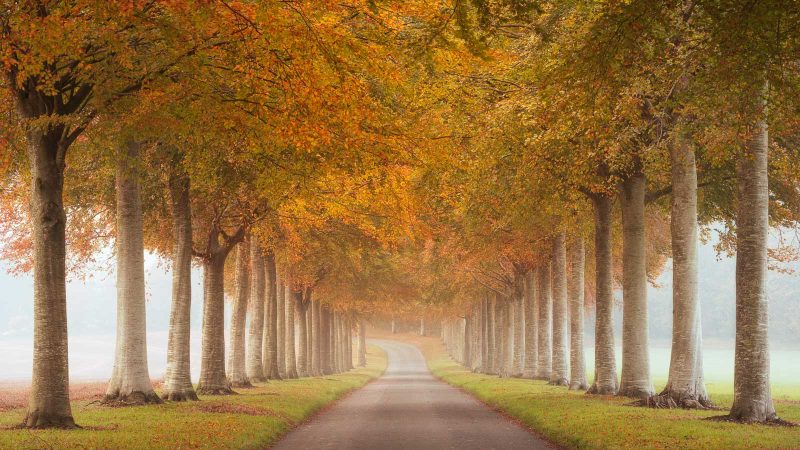How to Photograph the Seasons

Do you want to know the one constant that keeps me personally motivated and inspired when photographing landscapes all year round? It’s photographing the seasons.
The changing of the seasons is something that we all know, love, and experience here in the UK.


You might know that you are drawn to snow-topped mountains, the summer greens in local woodland, or the autumn leaves in your local wildlife reserve.
However, I feel strongly that every season has something to offer the nature photographer, particularly the landscape enthusiast.
As landscape photographers, we often get caught up in shooting sunrise and sunset. For some, this is simply not possible due to family and work commitments.

The beauty of focusing on the seasons, however, is that you can shoot at any time of the day; you just need to be willing to work with the conditions.
If you don’t know the best time of year to shoot a certain subject, then you have a go at shooting in all of them, no matter the time of day or weather forecast!
Keep reading for some of my top tips for photographing the seasons as a landscape photographer.
Return to the same location, season after season
Don’t be shy about revisiting iconic and sometimes popular locations.
There is always a new composition or moment to be captured as the seasons change and the weather varies.
Spend time getting to know a location well, and your eyes will open to endless opportunities around you. Sometimes it may take 3 or 4 visits to see something you would have otherwise missed.
Challenge: Shoot the same composition at different times of the year

Whether you have a local lone tree in the middle of a field, a sweeping meadow-scape, or an ancient woodland that you like to explore, set yourself the challenge of shooting the same place, and even the same composition in different seasons.
This is one of the most rewarding things I’ve done myself, and highly recommend everyone try it.
You will quickly understand how the direction of light changes the scene in front of your eyes, and how the colours at various times of the year may affect the mood of the image.
A top tip is to use Google Maps to pin your position and save it for future reference.
You could also use something more accurate like a GPS device (I use a Garmin Fenix 6X) or what3words, an application that has divided everywhere on the planet into 3m2 squares with a unique 3-word reference.
It makes it easier to trace your tracks and find exactly where you were standing.
Read more: How to Master Exposure in Your Landscape Photography
How to find photography locations
Places with vegetation, especially trees, will work particularly well for this challenge, as the landscape can change quite dramatically.
During spring and summer, the rich greens can look fantastic, and I find beech trees in particular make an incredible year-round subject to photograph.
Take a drive and see what you can find – you might even stumble across an avenue of trees or a tree-lined road that you can make work with leading lines and symmetry.

It is important when trying to shoot the same composition over time that you do your best to line up the images across time in the same way.
You could attempt to do this handheld with today’s cameras, however, I’m a firm believer in slowing down as much as possible.
This helps to fine-tune your composition, dial in your settings, and really think through your final photograph. A good sturdy tripod will help you to carefully frame up your chosen scene.
A little tip is to set yourself a few unchanging landmarks or pointers to remember where you stood; look for a certain tree, signpost, or even a mark in the road.
The metadata captured by your camera will help you remember things like focal length and settings.

Whilst geo-tagging your location, or finding out a 3m2 reference by using what3words, will help you return to the exact spot in the future.
You could also shoot the scene a little wider with the intent to crop later in post. Remember, you can always crop into a scene, but you can’t crop out once you get home.
The best and most exciting thing about returning to the same location season after season means you can begin to put together a series of images that tell a story.
It also gives you the motivation to get out every few months and revisit the same locations – especially in winter when it can be hard to find the motivation to do much of anything at all!
Read more: How to Find Great Locations for Landscape Photography
Winter: Be prepared to get cold and wet
Winter can offer some fantastic landscape photography opportunities. If you enjoy shooting dramatic seascapes and snowy landscapes, you know too well how the best conditions always come after some exciting weather.
One way to ensure you capture an iconic winter picture is to be prepared to go out during the rain, before or after a storm, and if you’re lucky, to safely explore the landscape after fresh snowfall.

To capture the essence of the winter season, photographers must embrace the conditions.
If it’s raining or snowing heavily, get on the waterproofs, grab an umbrella, and try increasing your ISO to something like ISO 320.
This will allow you to shoot with a shutter speed of 1/50th or even 1/200th and capture some of the falling rain/snow in front of your subject. Don’t be afraid to get creative and play with your settings.

Winter is the season of movement, and there are plenty of opportunities to capture creative landscape images!
The other advantage of being out during winter is you can get some incredible dramatic light. This is one of my favourite things to focus on throughout the months of January and February, especially if the forecast is showing on-and-off rain.
Get in position nice and early and you may have an opportunity to capture the light as it dances across the landscape. I find you often get an incredible dark orange glow in winter due to the low rising/setting sun.
Read more: Ideas for Photographing Winter Landscapes
Spring: Get lost in the woodlands
Where do I start with the season of spring? If this time of year doesn’t get you excited to be a landscape photographer, then I don’t know what will!
The fields begin to come alive, the forests fill with colour after a winter of rest, and the showers bring with them some of the best skies of the year!
Throughout the UK we are lucky to have many ancient woodlands, and from the end of April to early May many of them unveil a carpet of incredible colour as bluebells grace the forest floors.
Try shooting with the sun over your shoulder and wait for the first light to touch the trunks. A clear sky day with a hint of mist is all landscape photographers dream about during this 2–3-week window every year.

Another great technique to practice during spring is shooting panoramas. Most woodlands that are lucky enough to have carpets of bluebells are well sheltered from the wind, especially if it’s a foggy morning!
So, level out your tripod legs and use an L bracket to help you shoot portrait compositions more easily.
Then take several shots that overlap (a good rule of thumb is to overlap by 1/3rd when rotating left to right) to merge later in your preferred processing software.

From May to June most farmers will have their lands covered in yellow as the rapeseed comes out to play.
You must do your research and scout these locations a month or so in advance though, as farmers will rotate their crops, meaning you will very rarely see the same crop in the same field the following year.
Give yourself a day or two to scout locations and mark locations to return to when the ideal weather conditions arrive.
Bonus tip: Apply the same technique I mentioned in winter to capture the rain falling in the sky as you fill the foreground with fields of yellow.
A dark, moody sky makes a great backdrop for this vibrant colour to really pop during spring, and for the motion of raindrops to stand out.
Read more: How to Photograph Spring Landscapes
Summer: Get up early and stay up late
In the height of summer, sunrise and sunset can be as early as 04:55 and as late as 21:30 respectively. This means there is a lot of daylight to be had to get out and shoot.
The golden hour light at this time of year can often be harsh, especially if you are used to shooting in the softer autumn or winter light, and you may find yourself needing to use ND filters for long exposure shots.
I like to try a few different things at this time of year, embracing clear skies and shooting blue hour or pastel pinks over fields of barley and wheat.

Try experimenting with different mediums of photography; macro or wildlife, shooting down low on the ground at some colourful wildflowers, or out at sunrise watching birds of prey glide across the local farmland.
It’s a good time of year to experiment with different types of photography and use lenses that may otherwise be sitting on the shelf.
Clear summer evenings can often be spent chasing the light across the landscape. Try and find some unique vantage points with either the sun behind you or over your shoulder, giving you a better chance of some soft light as the sun sets.
If you’re shooting with a clear horizon, you may be able to capture the belt of Venus. An atmospheric phenomenon visible shortly before sunrise or after sunset that gives a pastel pink glow on the horizon.

July and August can be some of the hardest months to capture landscapes, so it’s the perfect time to head out and scout new locations for other seasons.
Pay particular interest to beech tree woodlands for autumn and rugged landscapes with plenty of foreground interest for winter.
Keep an eye out for crystal clear skies on the cooler summer evenings and you may be lucky enough to witness noctilucent clouds in the night sky.
They are one of the highest clouds at over 200,000 feet, located in the Mesosphere and are formed by ice crystals, reflecting in the sky, and providing great photo opportunities.

If you struggle with motivation to get out and shoot landscapes in the heat of the summer (we’ve all been there), try and give another medium of photography a go.
Get yourself a macro lens to explore outside with a new perspective, or a super-tele to try something completely different and capture some wildlife.
Read more: Inspiration for Summer Landscape Photography
Autumn: Chase the mist
I know mist is one of the most cliché things to capture at this time of year. However, if you find a clean woodland with straight trees and beautiful orange leaves, it’s very hard to resist photographing the scene in the morning mist or thick fog.
The separation you get from the background is almost impossible to replicate in any other condition. It can sometimes be imitated with rain if you’re lucky, but the contrast of orange against milky white is a particularly incredible combination.

This is when your hours of scouting in the summer for interesting forest compositions will pay off.
Re-visit those locations in late October and into November to experience them in a completely different light.
The colours will blow you away! You can even put your macro skills to use by capturing some fungi or wet leaves on a damp autumnal morning.
Read more: Autumn Photography Tips – Getting Creative
Using a polarising filter
This is the best and (in my opinion) only filter that you need with you at all times in autumn.
It will allow you to cut through glare on the wet leaves and it helps give the colours a real punch of vibrance, something impossible to replicate in post-production.
Be careful not to polarise too much though, as sometimes it can make your images look flat.
I recommend taking a few shots at different turns of the polariser so you can review them all later on the big screen and pick your favourite, as the differences can be quite subtle.

One of the best (and my favourite) months for autumn photography is September.
The rolling hills around north Dorset are prone to misty mornings and cloud inversions, with some of my favourite shots of Corfe Castle being captured during this incredible month.
The cold and clear nights, combined with humid days and low wind can almost guarantee a fantastic morning out with the camera. Just be prepared with a few backup locations in case the weather forecast was completely wrong.
Read more: The Essential Filters for Landscape Photographers
In conclusion
Each of the four seasons has so much to offer the nature photographer. There are often dramatic conditions perfect for capturing movement and creative nature imagery in the winter.
Springtime offers an abundance of new life in flora, fauna, and wildlife. Summer offers daylight in spades and colourful evening skies, and autumn gives us unbeatable opportunities to create mood and atmosphere in our images.
I highly recommend having a go at capturing the same location, and indeed the same composition, across all four of the seasons, and during the transitionary periods in between.
It’s an exciting and engaging experience and gives you a newfound appreciation for the changes that happen across time in one single spot in nature.
At the end of it, you will undoubtedly have a beautiful series of photographs that tell a story – who wouldn’t want that? Some of my favourite memories are tied to the images I have from projects like this.
These are just some reasons why I focus on shooting the seasons as a landscape photographer, and why I recommend you get out and shoot in all conditions throughout the year. There is always that special picture and memory waiting to be captured and experienced.





